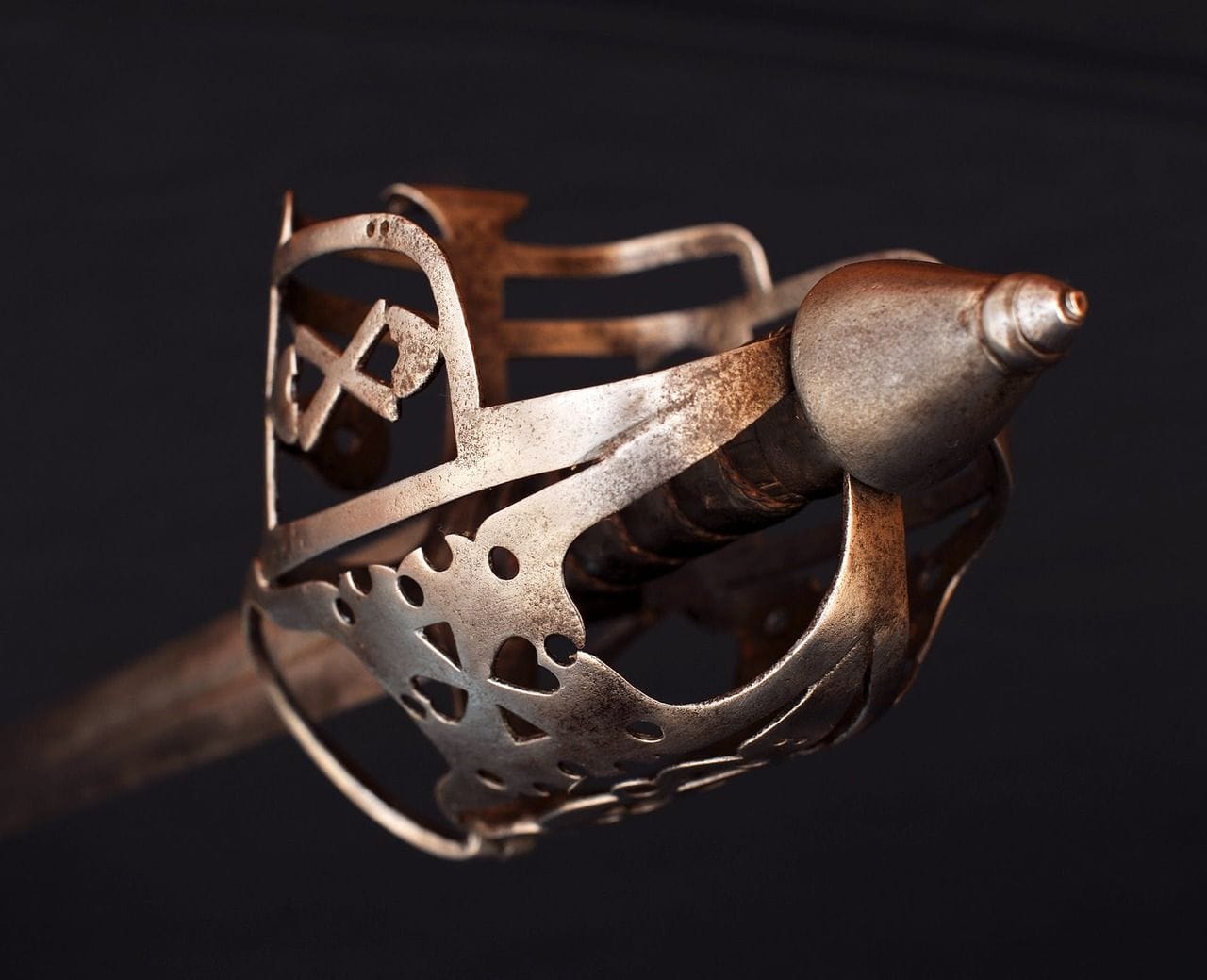The basket-hilted broadsword—a weapon instantly recognizable by its intricate, cage-like handguard—presents a fascinating study in military technology, craftsmanship, and cultural impact. This comprehensive guide explores its history, design, combat techniques, and enduring legacy, delving into regional variations and the ongoing debate surrounding its precise nomenclature and use.
A History Forged in Steel: From Battlefield to Museum
The basket-hilted broadsword’s evolution from simpler designs reflects changing combat styles and the increasing sophistication of metalworking. Its iconic fully-guarded basket hilt, a marvel of craftsmanship, provides unparalleled hand protection, dramatically altering sword fighting techniques. Ownership often signified status and military prowess, underscoring its importance beyond mere functionality. The earliest examples likely emerged in the late 16th century, with peak popularity spanning the 17th and 18th centuries before declining in military use; however, further research may refine these dates.
The Anatomy of a Masterpiece: Design and Construction
The basket-hilted broadsword’s effectiveness stemmed from a synergistic combination of blade and hilt. The blade itself, typically long and wide, was crafted from high-quality steel, carefully selected to optimize cutting power. Blade length, width, and the presence or absence of a fuller (a groove running along the blade) varied depending on regional preferences and intended use. Some experts believe these variations also reflected symbolic or cultural meanings, a theory currently under investigation. The basket hilt, the sword’s defining feature, completely encircles the hand, offering superior protection against enemy blades. Usually constructed from steel—often with decorative brass accents—it represents a significant leap forward in hand protection compared to earlier swords with only simple crossguards (quillons). The pommel, the weight at the end of the hilt, contributed to balance and control.
The Dance of Steel: Combat Techniques and Fighting Styles
The basket-hilted broadsword’s design directly influenced its fighting style. The protective basket hilt facilitated aggressive, close-quarters combat, unlike earlier swords that often prioritized defense. Many sources suggest a style emphasizing powerful cuts and slashes, executed with speed and precision. While some fencing manuals provide insights into these techniques, ongoing research is further illuminating the nuanced fighting methods employed. The superior hand protection allowed for more aggressive maneuvers, increasing the warrior’s effectiveness and survivability in combat.
Regional Variations: A Tapestry of Styles
While the basket-hilted broadsword saw widespread adoption across Europe, significant regional variations emerged. The Scottish basket-hilted broadsword, for instance, often featured a fuller and a slightly curved blade, potentially influencing its handling and balance. These regional adaptations reflect the influence of local fighting styles, available materials, and cultural preferences. Further research into specific regional styles and variations may reveal more subtle differences in design and fighting techniques. The Schiavona, for example, a basket-hilted sword developed in Italy and favored by Dalmatian mercenaries, provides a striking example of such regional differentiation.
A Timeline of the Basket-Hilted Broadsword
| Period | Key Developments |
|---|---|
| Late Middle Ages | Early hand protection developments on sword hilts. |
| 16th Century | Emergence of early basket-hilted sword designs. |
| 17th Century | Widespread military adoption across Europe. |
| 18th Century | Peak popularity and regional styles flourish. |
| 19th Century On | Reduced military use; becomes a prized collector’s item. |
What is a Basket Hilt Sword Called? Navigating Terminology
The most accurate and descriptive term for a sword with a basket hilt is a basket-hilted sword. Although terms like “broadsword” are frequently used interchangeably and indeed many basket-hilted swords were broadswords, it’s crucial to understand the nuances. “Broadsword” is a broader category encompassing various wide-bladed swords, not all of which had basket hilts. The term “claymore,” often associated with Scottish basket-hilted swords, specifically refers to a large, two-handed greatsword.
The Basket Hilt’s Evolutionary Significance
The development of the basket hilt represented a significant advancement in sword design. Early swords often featured simple quillons (crossguards), offering minimal hand protection. The basket hilt, in contrast, completely enclosed the hand, mitigating the risk of injury and enabling more aggressive fighting styles. The intricacy and quality of basket hilts also varied greatly, showcasing the skill of the blacksmiths who created them, and often reflecting the material and cultural context of production.
Regional Diversity in Basket-Hilted Swords
Basket-hilted swords were far from uniform across Europe. Their design evolved differently in various regions, influenced by local fighting techniques and the available materials. The Scottish Highland claymore, for example, represents a distinctive type of greatsword often incorporating a basket hilt. The Schiavona, developed in Italy, highlights another regional variance in design and technique. Each variation reflects the specific cultural and martial heritage of its region of origin.
What is a Scottish Broadsword Called? Clarifying the Claymore
The terms “claymore” and “broadsword” are often confused when discussing Scottish swords, but they represent distinct weapons. “Claymore,” meaning “great sword” in Gaelic, originally referred to large, two-handed swords. However, over time, it became associated with the single-handed basket-hilted broadsword, leading to much confusion.
The Scottish Basket-Hilted Broadsword: A Closer Look
The Scottish basket-hilted broadsword, prominent from the 16th to 18th centuries, was a single-handed weapon characterized by its distinctive basket hilt and usually a broad, sometimes slightly curved blade. The quality of steel and craftsmanship often surpassed that of other regions, with masters like Andrea Ferrara achieving legendary status for their skill. The weapon’s balance and design allowed for both cutting and thrusting techniques. Some experts suggest this sword was particularly suited to fluid, agile movements, contrasting with the slower, more powerful attacks typical of the two-handed claymore.
The Enduring Symbolism: Beyond the Battlefield
The Scottish basket-hilted broadsword transcended its practical function to become a potent symbol of Scottish identity. Its association with clan warfare, the Jacobite risings, and broader Scottish heritage continues to resonate today. Museums worldwide house significant examples, and modern replicas allow enthusiasts and reenactors to appreciate its design and fighting techniques.
Claymore vs. Basket-Hilted Broadsword: A Comparison
| Feature | Claymore | Basket-Hilted Broadsword |
|---|---|---|
| Blade Length | Significantly longer | Shorter (approximately 3-3.5 feet) |
| Number of Hands | Two-handed | One-handed |
| Hilt Design | Generally simpler | Elaborate basket hilt for superior hand protection |
| Typical Period | Predominantly pre-16th century | Primarily 16th-18th centuries |
| Combat Style | Powerful, two-handed swings and thrusts | Faster, more agile slashing and thrusting |
Broadsword vs. Longsword: Unpacking the Differences
While the terms “broadsword” and “longsword” are often used interchangeably, significant differences in design and fighting style exist. The key distinctions lie in blade shape, hilt design, and the resultant combat techniques.
Comparing Broadsword and Longsword Features
| Feature | Broadsword | Longsword |
|---|---|---|
| Blade | Typically single-edged, shorter, wider | Usually double-edged, longer, narrower |
| Hilt | Distinctive basket hilt for superior hand protection | Simpler hilt design, offering varying levels of hand protection |
| Fighting Style | Aggressive, close-quarters combat, slashing focused | More versatile, incorporating a range of cutting and thrusting techniques |
| Primary Advantage | Superior hand protection, powerful cuts | Reach, versatility of combat capabilities |
The Scottish basket-hilted broadsword, although a type of broadsword, stands apart with its uniquely designed basket hilt and often slightly curved blade. These features likely reflect regional preferences and fighting traditions. It is crucial to distinguish this weapon from the two-handed claymore, a significantly larger and heavier sword.
The ongoing research of these iconic weapons continues to broaden our understanding of their design, manufacturing, and martial applications. The complexities and uncertainties involved underscore the need for sustained academic interest.
- Unveiling the Enigma: Mansoureh Khojasteh Bagherzadeh’s Public Appearances & Private Life in Iran - July 18, 2025
- Unveiling the Mystery: Mansoureh Khojasteh Bagherzadeh’s Husband: A Rare Glimpse into a Private Life - July 18, 2025
- Unveiling Masoud Khamenei’s Mother: Power, Influence, and Iran’s Future - July 18, 2025
















